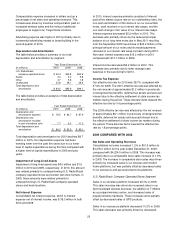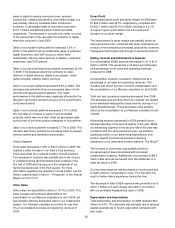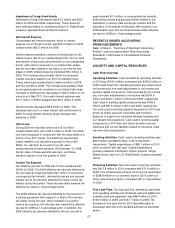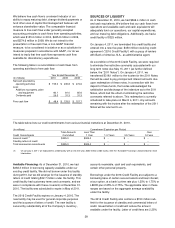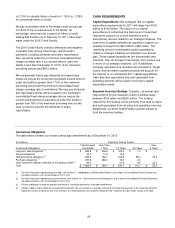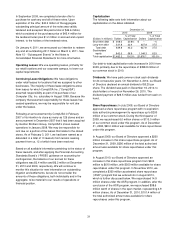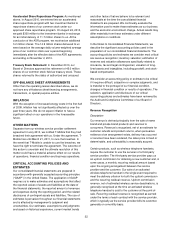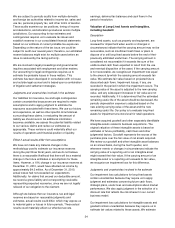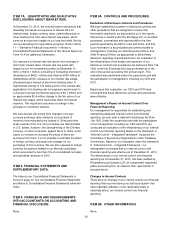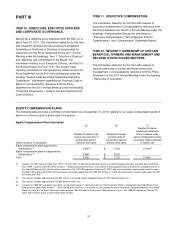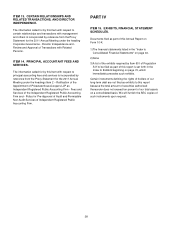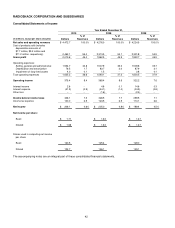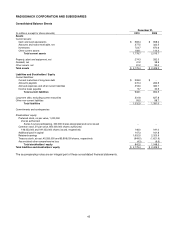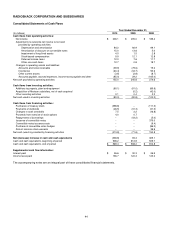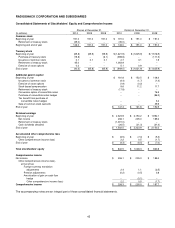Radio Shack 2010 Annual Report Download - page 45
Download and view the complete annual report
Please find page 45 of the 2010 Radio Shack annual report below. You can navigate through the pages in the report by either clicking on the pages listed below, or by using the keyword search tool below to find specific information within the annual report.35
fair values based on various valuation techniques such as
discounted cash flows and other comparable market
analyses. These types of analyses contain uncertainties
because they require us to make judgments and
assumptions regarding future profitability, industry factors,
planned strategic initiatives, discount rates and other
factors.
Effect if actual results differ from assumptions
We have not made any material changes in the accounting
methodologies we use to assess impairment loss for long-
lived assets, intangible assets, or goodwill during the past
three fiscal years, and we do not believe there is a
reasonable likelihood that there will be a material change in
the estimates or assumptions we use in calculating these
impairment losses. However, if actual results or
performance of certain business units are not consistent
with our estimates and assumptions, we may be exposed to
additional impairment charges, which could be material to
our results of operations.
The total value of our goodwill and intangible assets at
December 31, 2010, was $41.9 million. Of this amount,
$37.8 million related to goodwill from the purchase of
RadioShack de Mexico. Based on our most recent review
of goodwill impairment, we noted that the fair values of our
reporting units were substantially greater than their carrying
values.
Stock-Based Compensation
Description
We have historically granted certain stock-based awards to
employees and directors in the form of non-qualified stock
options, incentive stock options, restricted stock and
deferred stock units. See Note 2 - “Summary of Significant
Accounting Policies” and Note 7 - “Stock-Based Incentive
Plans” in the Notes to Consolidated Financial Statements
included elsewhere in this Annual Report on Form 10-K for a
more complete discussion of our stock-based
compensation programs.
At the date an award is granted, we determine the fair value
of the award and recognize the compensation expense
over the requisite service period, which typically is the
period over which the award vests. The restricted stock and
deferred stock units are valued at the fair market value of
our stock on the date of grant. The fair value of stock
options with only service conditions is estimated using the
Black-Scholes-Merton option-pricing model. The fair value
of stock options with service and market conditions is
valued utilizing a lattice model with Monte Carlo
simulations.
Judgments and uncertainties involved in the estimate
The Black-Scholes-Merton and lattice models require
management to apply judgment and use highly subjective
assumptions, including expected option life, volatility of
stock prices, and employee forfeiture rate. We use
historical data and judgment to estimate the expected
option life and employee forfeiture rate, and use historical
and implied volatility when estimating the stock price
volatility. Changes in these assumptions can materially
affect the fair value estimate.
Effect if actual results differ from assumptions
We have not made any material changes in the accounting
methodologies used to record stock-based compensation
during the past three years. While the assumptions that we
develop are based on our best expectations, they involve
inherent uncertainties based on market conditions and
employee behavior that are outside of our control. If actual
results are not consistent with the assumptions used, the
stock-based compensation expense reported in our
financial statements may not be representative of the actual
economic cost of the stock-based compensation.
Additionally, if actual employee forfeitures significantly differ
from our estimated forfeitures, we may have an adjustment
to our financial statements in future periods. A 10% change
in our stock-based compensation expense in 2010 would
have affected our net income by approximately $1.0 million.
FACTORS THAT MAY AFFECT FUTURE RESULTS
Matters discussed in our MD&A and in other parts of this
Annual Report on Form 10-K include forward-looking
statements within the meaning of the federal securities
laws, including Section 27A of the Securities Act of 1933,
as amended, and Section 21E of the Exchange Act. These
forward-looking statements are statements that are not
historical and may be identified by the use of words such as
“expect,” “believe,” “anticipate,” “estimate,” “intend,”
“potential” or similar words. These matters include
statements concerning management’s plans and objectives
relating to our operations or economic performance and
related assumptions. We specifically disclaim any duty to
update any of the information set forth in this report,
including any forward-looking statements. Forward-looking
statements are made based on management’s current
expectations and beliefs concerning future events and,
therefore, involve a number of assumptions, risks and
uncertainties, including the risk factors described in Item
1A, “Risk Factors,” of this Annual Report on Form 10-K.
Management cautions that forward-looking statements are
not guarantees, and our actual results could differ
materially from those expressed or implied in the forward-
looking statements.


